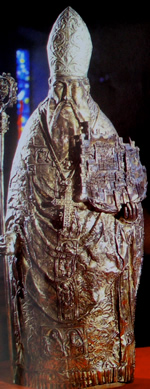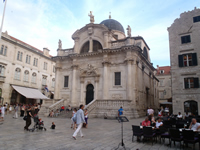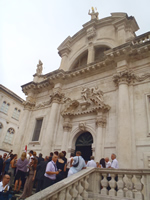 St. Blasius (Vlaho - Croatian) has been revered in Dubrovnik as the patron saint for a long time. According legend in the year 971, on the night of 2nd to 3rd February Venetian ships anchored in front of Dubrovnik under pretense of taking up water and provision before proceeding further east. A priest named Stojko walked up to the church of St Stephen (Stjepan - Croatian) on Pustijerna (a part of the City) that night. He found that the doors of the church had been left wide open. In the church he stumbled upon a gray old man with a battalion of heavenly forces. The old man told him to warn the City council that the Venetians are planning to attack the City, and that he was pushing them away of the City for several nights now. When Stojko had asked him who he was, the old man replied that he was Vlaho (Blasius). Later Stojko had alarmed the City of the Venetian threat and as the Venetians saw that the doors of the City had been closed and that the walls were manned, they heaved up their anchors and abandoned their plans of the surprise attack on the City. Since that day St. Blasius became the patron saint of Dubrovnik. St. Blasius (Vlaho - Croatian) has been revered in Dubrovnik as the patron saint for a long time. According legend in the year 971, on the night of 2nd to 3rd February Venetian ships anchored in front of Dubrovnik under pretense of taking up water and provision before proceeding further east. A priest named Stojko walked up to the church of St Stephen (Stjepan - Croatian) on Pustijerna (a part of the City) that night. He found that the doors of the church had been left wide open. In the church he stumbled upon a gray old man with a battalion of heavenly forces. The old man told him to warn the City council that the Venetians are planning to attack the City, and that he was pushing them away of the City for several nights now. When Stojko had asked him who he was, the old man replied that he was Vlaho (Blasius). Later Stojko had alarmed the City of the Venetian threat and as the Venetians saw that the doors of the City had been closed and that the walls were manned, they heaved up their anchors and abandoned their plans of the surprise attack on the City. Since that day St. Blasius became the patron saint of Dubrovnik.
Through the centuries St Blasius presented an inspiration to the large number of artists who painted and sculptured his image. Hundreds of statues of St. Blasius can be found throughout the City. On every corner of Dubrovnik City walls you will notice a statue of St. Blasius, embedded in the walls, watchfully starring to the distance anticipating hostile intents, protecting the City on his watch.
St. Blasius could be singled out as the most used motif in arts in Dubrovnik. Since the year 972 a celebration in the honour of St. Blasius is held in the City. This tradition is still alive today as every February the 3rd Dubrovnik welcomes thousands of visitors to participate in the celebration of the patron day in the Festival od St. Blasius.
In the honour of the patron saint, the Church of St. Blasius was erected in the City.
The present day church of St. Blasius was constructed by Venetian architect Marino Gropelli in in 1715 on the commission by the city authorities.
The church was built on the place of an old Romanesque church from 1368 that was significantly damaged in the Great earthquake of 1667 and finally destroyed in the fire that struck it in 1706.
 The new Church of St Blasius was built in Baroque style according to the prototype of St. Mauritius church in Venice. A large staircase leads to the ornamented main portal and a large dome decorates the roof of the church. The interior of the church is furnished in great detail, and the marble altars are particularly impressive. The centre piece of the main altar is a gothic statue of St. Blasius in gold-plated silver from the 15th century that holds in his hand a model of the City as it looked before the earthquake. The statue is a work of an unknown artist of Dubrovnik gild school and it is the most valuable work of art in the long history of Dubrovnik. Historically the statue is quite important as the model of Dubrovnik in St Blasius hands distinctly depicts how the buildings before the Great earthquake looked like. It is interesting to notice that the statue, including some other valuables, was undamaged in the great earthquake and later in the fire that destroyed the old church which was interpreted as a sign and a miracle. The new Church of St Blasius was built in Baroque style according to the prototype of St. Mauritius church in Venice. A large staircase leads to the ornamented main portal and a large dome decorates the roof of the church. The interior of the church is furnished in great detail, and the marble altars are particularly impressive. The centre piece of the main altar is a gothic statue of St. Blasius in gold-plated silver from the 15th century that holds in his hand a model of the City as it looked before the earthquake. The statue is a work of an unknown artist of Dubrovnik gild school and it is the most valuable work of art in the long history of Dubrovnik. Historically the statue is quite important as the model of Dubrovnik in St Blasius hands distinctly depicts how the buildings before the Great earthquake looked like. It is interesting to notice that the statue, including some other valuables, was undamaged in the great earthquake and later in the fire that destroyed the old church which was interpreted as a sign and a miracle.
 The other interesting works in the church are the two stone statues (St. Blasius and St. Jerome), works by the Brac sculptor Nikola Lazanic from the end of the 16th century, which are also originally from the old church. The other interesting works in the church are the two stone statues (St. Blasius and St. Jerome), works by the Brac sculptor Nikola Lazanic from the end of the 16th century, which are also originally from the old church.
Among many great venues for a wedding in Dubrovnik, St Blasius church is one of the favourite wedding ceremony churches in Dubrovnik. The rich Baroque decoration inside the church provides for the amazing photo shoot and the location of the church amidst Dubrovnik is perfect, befitting even a royal wedding. |